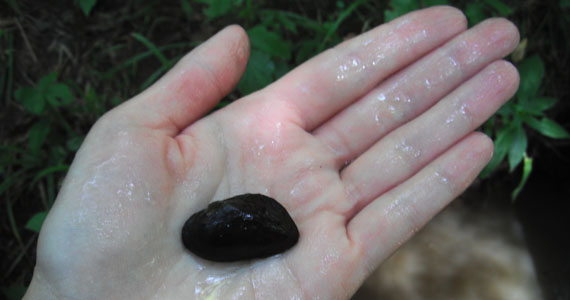Modeling effects of climate and land use changes on common and imperiled freshwater mussel occurrence in the Tar River Basin, North Carolina

Remember the mother-of-pearl buttons you used to find in the drawers at Grandma’s house? They have since been replaced by plastic buttons, but the freshwater pearly mussels that provided them still inhabit the streams that run through your backyard. Not only do freshwater mussels provide beautiful shells and pearls that we can enjoy, they also provide valuable services for their underwater neighbors. Freshwater mussels are filter-feeders. This means that as they eat they are also cleaning up streams and providing nutrients to the benefit of fish and aquatic insects. Unfortunately, these remarkable animals are urgently in need of protection and conservation. Nearly 70% of the 300 species in North America are endangered, threatened, of special concern, or already extinct (Williams et al. 1993). Climate change is another assault on these already endangered animals, and our prior research has shown that some freshwater mussels are already living close to their thermal limits (Pandolfo et al. 2010). Rising water temperatures and drought that may result from climate change have the potential to impact mussel health and negatively affect the valuable services they provide (Spooner and Vaughn 2008). More alarmingly, freshwater mussels that are already on the edge of their thermal tolerance may go extinct as a result of climate change if we do not put measures in place to protect them.
My dissertation project is a collaborative effort between North Carolina State University, the United States Geological Survey, and the North Carolina Wildlife Resources Commission that will help to predict the responses of freshwater mussels to climate change and develop strategies to mitigate the detrimental effects it may cause. The southeastern United States supports the highest global diversity of freshwater mussels, and the Tar River Basin right here in North Carolina supports a diverse mussel community that includes a number of imperiled species, including the federally endangered Tar River spinymussel (Elliptio steinstansana) and dwarf wedgemussel (Alasmidonta heterodon). We selected 20 sites within the Tar River Basin that span a broad range of environmental conditions. Each site was surveyed for common (e.g., Elliptio complanata) and imperiled mussels and fish. Microhabitat parameters were measured at base flow conditions at all sites. These parameters, including depth, velocity, substrate, cover, and sediment compaction will be combined with habitat availability data to describe microhabitat suitability of freshwater mussels in the basin. We will then identify the physical and hydraulic parameters that best describe the occurrence of mussels by selecting the most parsimonious models that quantify these relationships. The resulting habitat suitability data and mussel occupancy models will be incorporated into watershed and in-stream biological response models for mussels that will be used to simulate scenarios related to climate and land use change to guide conservation efforts.
Contributed by Tamara J. Pandolfo, Ph.D. student
NCSU Department of Biology, North Carolina Cooperative Fish and Wildlife Research Unit
[divider]
Co-advisors:
Thomas J. Kwak, NCSU Department of Biology, North Carolina Cooperative Fish and Wildlife Research Unit, United States Geological Survey
W. Gregory Cope, NCSU Department of Environmental and Molecular Toxicology
[divider]
References
Pandolfo, T.J., W.G. Cope, C. Arellano, R.B. Bringolf, M.C. Barnhart, and E. Hammer. 2010. Upper thermal tolerances of early life stages of freshwater mussels. Journal of the North American Benthological Society 29:959-969.
Spooner, D.E., and C.C. Vaughn. 2008. A trait-based approach to species’ roles in stream ecosystems: climate change, community structure, and material cycling. Oecologia 158:307-317.
Williams, J.D., M.L. Warren Jr., K.S. Cumming, J.L. Harris, and R.J. Neves. 1993. Conservation status of freshwater mussels of the United States and Canada. Fisheries 18(9):6-22.
- Categories: